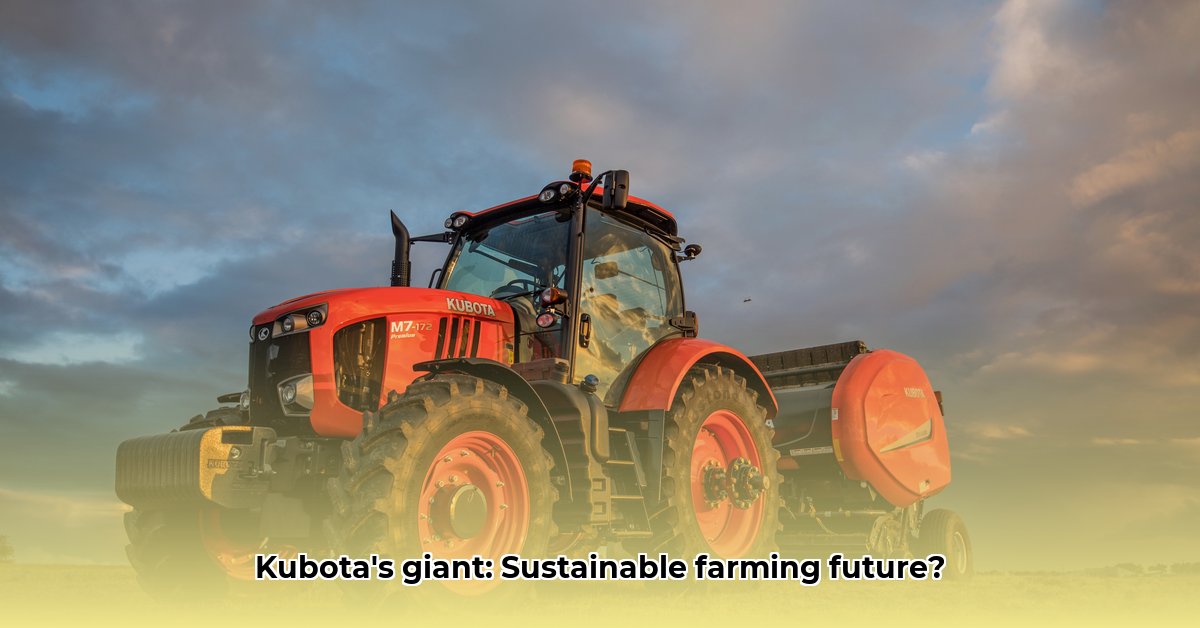
Kubota's M8 Tractor: Productivity Gains vs. Environmental Concerns
Kubota's M8 series tractor, a powerhouse exceeding 200 horsepower in some models, promises significant productivity gains for large-scale agriculture. However, its environmental impact remains a critical question. This analysis examines the M8's performance, operator comfort, environmental footprint, market implications, and the responsibilities of various stakeholders in ensuring its contribution to a sustainable agricultural future. The lack of readily available data on fuel efficiency and emissions presents a key challenge in assessing its true sustainability. For comparison, consider the power of larger tractors.
Power and Performance: A Giant Leap Forward?
The M8 boasts impressive power and performance capabilities, enabling farmers to significantly increase output across various tasks. Its high horsepower allows for faster completion of large-scale operations, such as harvesting and tilling. But, while this raw power translates to increased efficiency and reduced labor costs, the question remains: does this efficiency come at the cost of increased fuel consumption and a larger carbon footprint? Further data on fuel efficiency per unit of work completed is needed to fully assess this.
Operator Comfort and Efficiency: Ergonomics and Productivity
Kubota emphasizes operator comfort in the M8's design. The spacious cab (148 cubic feet) and ergonomic features aim to minimize driver fatigue and maximize productivity. Reduced operator fatigue translates to fewer errors and increased efficiency, potentially offsetting some of the environmental impact through superior resource management. However, the extent to which these ergonomic improvements translate into measurable reductions in fuel consumption or other environmental factors requires further investigation.
Environmental Impact: The Missing Data
This is perhaps the most critical area where information is lacking. Crucial data concerning the M8's fuel efficiency and greenhouse gas emissions is currently unavailable. Without this, a precise evaluation of its environmental impact is impossible. While improved efficiency in task completion could lead to reduced overall fuel consumption compared to older models, the sheer power of the M8 might also result in higher fuel usage per hour of operation. Experts suggest that lifecycle analyses, including manufacturing, operational usage, and eventual disposal, are vital to fully understand the environmental consequences. This lack of transparency hinders a complete assessment of sustainability.
Synergies and Supply Chain: Optimizing Resource Use?
Kubota's existing equipment lineup offers potential synergies with the M8, possibly streamlining farming operations. This could contribute to improved resource utilization and efficiency in the broader supply chain. However, it remains crucial to analyze the complete environmental footprint, from manufacturing to disposal, to understand the full impact. A comprehensive "cradle-to-grave" assessment is missing. Therefore, the claims regarding supply chain optimization and their impact on sustainability require further investigation and supporting data.
Market Positioning: Implications for Sustainable Agriculture
The M8's focus on large-scale farming operations raises questions regarding its impact on smaller farms and the overall distribution of resources. Does its increased efficiency only benefit larger operations, potentially exacerbating existing inequalities within the agricultural sector? Or could its enhanced productivity indirectly benefit smaller farms through increased overall efficiency in the food production chain? A detailed market analysis is needed to assess its broader implications for sustainable agricultural practices and the economics of farm sizes.
Conclusion: A Call for Transparency and Further Research
The Kubota M8 presents a significant technological advancement in agricultural machinery. However, a comprehensive assessment of its sustainability remains elusive due to the absence of essential data. Kubota must publicly release comprehensive fuel efficiency and emissions data. Independent researchers must conduct rigorous life-cycle assessments to determine its complete environmental footprint. Only with transparency and rigorous research can we determine if the M8 truly supports sustainable agriculture or exacerbates existing environmental concerns. The future of sustainable farming hinges on these answers.
Stakeholder Responsibilities: Collaboration for a Sustainable Future
The future success of sustainable farming practices related to the M8 hinges on the collaborative efforts of several key stakeholders:
Kubota: Must publish comprehensive lifecycle impact data including fuel efficiency, greenhouse gas emissions, and detailed manufacturing processes. Investment in sustainable technologies, like alternative fuel systems, is critical.
Large-Scale Farmers: Need to perform thorough cost-benefit analyses, incorporating environmental costs and long-term sustainability impacts. Adoption of precision farming techniques and exploration of alternative fuels are key steps.
Agricultural Researchers: Must conduct rigorous lifecycle assessments (LCA) focusing on environmental impacts. Standardized metrics are needed for evaluating large agricultural equipment's sustainability.
Policymakers: Stronger environmental regulations for agricultural machinery and incentives that promote sustainable practices are essential.
The Kubota M8 presents a significant step forward, but its long-term impact on sustainable agriculture requires collaborative action and transparent research. Only through such commitment can the agricultural industry fully harness this technology's power while minimizing its environmental consequences.